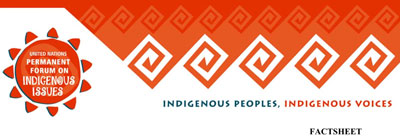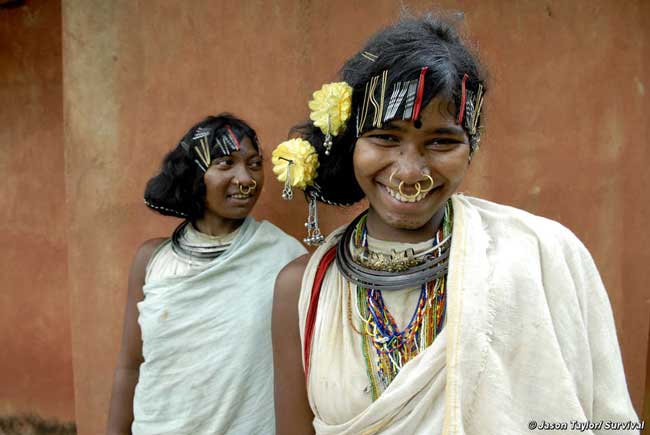
UN Permanent Forum on Indigenous Issues >>
Tribal and indigenous communities across the world have been asserting their rights to the mineral wealth often found under the land they own or possess or have traditional rights to. They have been historically denied even a share of that huge wealth, leave alone legal rights of ownership. Under the contemporary deregulated neo-liberal policy framework, the exploitation and plunder of natural resources, including minerals, by domestic corporates and multinational mining companies has intensified. But the resistance by affected communities across the world has also grown and is reflected, over the years, in the establishment of an international framework through ILO and U.N. Conventions, which recognise in varying degrees the rights of indigenous and tribal communities to ownership, control and management of land and resources traditionally held by them either individually or as a community; the right to a decisive role in decision making for development needs in their areas; and the right to prior, free and informed consent to any projects in their areas. […]
The issue has immediate relevance for India, as the UPA government has introduced a Mining and Minerals (Development and Regulation) Amendment Bill, 2011 (MMDRA), which is presently before the Parliamentary Standing Committee. […]
In India, ownership of minerals lies with the State. However, the Central government which has control over all major minerals like iron ore, bauxite, copper, coal and most State governments which have control over minor minerals like sand, stone, granite, etc., have promoted privatisation through leasing mines to private companies apart from handing over captive mines of iron ore and bauxite to steel and aluminium corporates like the Tatas and Birlas. According to a recent report compiled for the industry by Ernst and Young, of the 4.9 lakh hectares of land given out in mining leases in 23 States by the end of 2009, 95 per cent of the leases comprising 70 per cent of the land were given to private companies.
The MMRDA Bill […] gives weightage, in the allocation of leases, to a set of criteria which favour such companies and also allows them activity on much larger tracts of land than previously. This has adverse implications for equity, the environment and growth.
While these aspects need comprehensive analysis, here we focus on those provisions, which claim to address the rights of tribal communities. There is a provision that makes it mandatory for coal mining companies to give funds amounting to 26 per cent of the profits. […]
Interestingly, in the U.S. where the Federal Government had set up trusts to manage funds paid by companies using the land on reserves owned by Native Indians, the government was recently forced to pay a compensation of $1.2 billion to 41 Native American communities for “mismanagement of the assets” of the trust and is expected to have to pay another $3.4 billion in a similar case. When the affected people do not have a decisive say in the management of such funds, as in the case of the proposed district mineral foundation in the MMRDA Bill, “mismanagement” is inevitable. Also, rates of royalties in India are notoriously low. Until recently, for example, the royalty for one tonne of iron ore fixed by the Central government for Orissa [Odisha] was just Rs. 26. With a low extraction cost of only Rs. 250 to 300 per tonne and a high market price around Rs. 7,000 a tonne, mining companies made huge profits. While royalty rates have been recently increased, it is still a pittance compared to the profits companies make. […]
The Bill gives legal sanction to the arbitrary rights of governments, both at the Centre and the States, to give different types of licences and leases from reconnaissance to exploration, prospecting and finally extraction without any procedure for even consulting, leave alone taking the consent of tribal communities. The only reference to “consultation” (not consent), is for the grant of licences for minor minerals (but not major) in Fifth and Sixth Schedule areas where “the gram sabha or the District council, as the case may be shall be consulted.” […]
In Fifth Schedule areas, the law prohibits transfer of tribal held land to non-tribals. Different States have also enacted such laws like 70/1 in Andhra Pradesh, the Chotanagpur Tenancy Act and the Santhal Parganas Tenancy Act in Jharkhand. None of the mining companies that gets leases is owned by adivasis. Presumably this was the reason why in the Samata case, the Supreme Court held that sale, transfers and even leases of tribal land to non-tribals are illegal. […]
There are other issues such as compensation and compensatory jobs in lieu of lost livelihood which are inadequate and also ambiguous. With cuts in permanent jobs and widespread contractual and casual work in the mining sector, the promise of employment to land losers cannot be taken at its face value. […]
India, which is a signatory to many international conventions on the protection of tribal rights, is violating these conventions and adding to the burden of historical injustice. The Bill, in its present form, should and must be opposed and resisted. Concerned movements should work together for an alternative model which will recognise the ownership and other rights of tribal communities in mining in Fifth Schedule and tribal areas through effective legal mechanisms.
(Brinda Karat is a member of the Polit Bureau of the Communist Party of India – Marxist.)
Source: “Of mines, minerals and tribal rights” by Brinda Karat, The Hindu (Opinion) 15 May 2012
Address : https://www.thehindu.com/opinion/lead/article3419034.ece
Date Visited: 2 November 2021
[Bold typeface added above for emphasis]

Photo © Survival International
“In Rayagada in Odisha, Kondh parents distinguish between dangar patha (mountain learning) and kagaj patha (paper learning). Asked which they prefer, many parents answer ‘both’. This expresses a need deeply felt by Adivasis: literacy, with fluency in the regional language or English, is important; but so is respect for native languages and knowledge systems linked to the land and forest.” – Felix Padel & Malvika Gupta in “Are mega residential schools wiping out India’s Adivasi culture?” (The Hindu, 13 February 2021) | Indian tribal cultural heritage | Odisha | Rayagada by PARI >>
“English newspapers are worse than Hindi on representing Dalit, Adivasi writers.” – (The Caravan, 3 August 2019) >>
Continents & countries
Tip: click on any red marker for details on endangered languages in a particular region of India.
Please note: the facts and figures cited (via hyperlinks) links call for updates and fact checking >>
Cultural invisibility – India’s 600 potentially endangered languages | Linguistic Survey of India (official website) >>